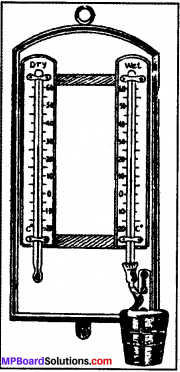In this article, we will share MP Board Class 7th Social Science Solutions Chapter 9 Temperature Pdf, These solutions are solved subject experts from the latest edition books.
MP Board Class 7th Social Science Solutions Chapter 9 Temperature
MP Board Class 7th Social Science Chapter 9 Text Book Questions
Choose the correct alternatives:
Mp Board Class 7 Social Science Chapter 9 Temperature Question 1.
The temperature decreases 1°C at the height of:
(a) 165 m
(b) 156 m
(c) 161 m
(d) 561 m
Answer:
(a) 165 m
Class 7th Social Science Chapter 9 Temperature Question 2.
The process of rising up of air after heating is known as:
(a) Radiation
(b) Isolation
(c) Convection
(d) Reflection.
Answer:
(c) Convection
Fill in the blanks:
- The heat radiated by the sun is called …………….
- The heat re-radiated by the earth is called ……………..
- The difference between maximum and minimum temperature is known as …………..
Answer:
- radiation
- Terrestrial radiation
- diurnal range of temperature.
MP Board Class 7th Social Science Chapter 9 Short Answer Type Questions
Class 7 Social Science Chapter 9 Temperature Question 1.
What is temperature?
Answer:
The degree of coldness or hotness in the air is known as temperature.
Mp Board Class 7th Social Science Chapter 9 Temperature Question 2.
What are the three processes by which air is heated?
Answer:
The three processes by which air is heated are:
- Isolation
- Radiation
- Convection
Social Science Class 7 Chapter 9 Temperature Question 3.
What is the difference between solar isolation and terrestrial radiations?
Answer:
The heat emitted-by the sun is called solar isolation, whereas the heat radiated back by the earth is called terrestrial radiation.
MP Board Class 7th Social Science Chapter 9 Long Answer Type Questions
Mp Board Class 7 Science Chapter 9 Temperature Question 1.
Describe the factors which affects the temperature.
Answer:
The factors which affect the temperature are:
1. The angle made by sun’s rays – The atmosphere surrounding the earth is circular. The rays coming from the sun is generally straight but due to the spherical shape of the earth, it reaches at different places in different angles. The rays of die sun falls vertical at the equator and slanting at the poles. The vertical rays fall over a short area and therefore receives more heat. The slanting rays of the sun have less heat.
2. The distance traveled by the sun’s rays in the atmosphere – The vertical rays of the sun have to pass through a short distance while the slanting rays have to cover a longer distance. As a result the intensity of the heat is higher in the first case and lower in the second case.
3. Height from Sea level – The temperature falls when we move higher from die sea level. The mountains are cooler than plains.
4. Duration of the day – The longer the duration of the day the greater is the isolation and die shorter the duration of the day the smaller will he the isolation.
Class 7 Geography Chapter 9 Pdf Temperature Question 2.
Explain an ordinary thermometer by illustrations.
Answer:
The instrument used to measure temptation is known as thermometer. The measuring unit of temperature is centigrade.

Thermometer